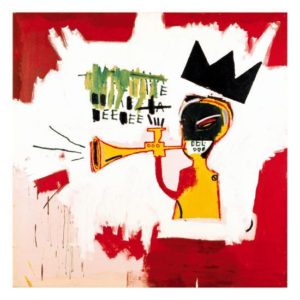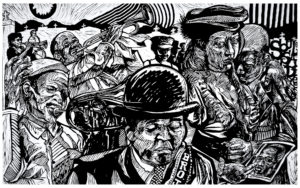Before attending class on March 29th, 2019 I was excited. I knew that during class we were going to paint. Therefore, when Garth Freeman first began the lecture with other artists I was intrigued. Before taking this class I would have looked at art and thought how is that art? But now, with all the additional tools I have collected along the way, I was able to see why a certain person was an artist and try to interpret the work instead of looking at it.

Trumpet by Jean-Michel Basquiat

The person who showed me that I progressed was Jean-Michel Basquiat. When Freeman put up an art piece by Basquiat, I recognize that in the past I would’ve laughed and said it’s just lines drawn in an aggressive manner. But, because of this class and understanding that art can take numerous shapes and expression, I noticed my progress. During class, I leaned over to Corinne and told her my thoughts about how before I would not have understood why Basquiat is classified as an artist, but now I see it. For example, his art piece Trumpet has complexity to it just like Steve Prince’s art pieces. In Basquiat’s, it has music like Steve Prince’s artwork (Requiem for Brother John, for example). However, Basquiat’s work differs with the incorporation of letters compared to Prince. In addition, he incorporates a symbol, the crown. This correlates to Prince’s artwork with his symbolism of the Holy Spirit with the handkerchief. For both artists, you cannot glance at their artwork and walk away. Instead, you have to slow down and truly look at what is being presented and try to understand the meaning behind the piece.
This relates to the interactive activity we did in class on this day. Freeman wanted us to create monoprints with a group of students based on the W.E.B DuBois The Souls of Black Folk chapter “Of the Passing of the First-Born.” Freeman wanted us to either paint an image that resonated with us or to paint how we felt about the passage. For our group, I suggested we do something with the veil because it was a huge presence in the chapter for DuBois. With this one idea, we took off. I first started off by writing the word “Veil” in red and the rest of my members joined in. We first used somber, dark colors. This correlated to the death of DuBois infant child and melancholy mood of the chapter. But then, we said we wanted lighter colors. Abby had the idea of putting the lighter colors into the word the “Veil”. I thought this was a brilliant idea. I am not sure if this was her intention, but I thought it could symbolically mean that although the veil is still there, hope can break it. This reminds me of the very first time I was involved in an art project: “Urban Garden” with Steve Prince for our school. Throughout the week students were allowed to come in and draw whatever they wanted to. This meant that students contributed or created new ideas to preexisting ones that were on the charcoal paper. In the end, it was a community effort that people collaborated together.
The class activity is exactly like this because we all were working together and creating a piece of artwork without a concise plan. Seeing how people chose dark colors than light colors, how people chose different movement with lines, swirls, or zigzags was invigorating and inspiring. When I saw others paint it was interesting to see their thought process compared to mine and how we fed off of each other. This reminds me of life with art. Freeman mentioned how he, as an artist, mimics other artists for a starting point for a piece of work. This holds true for Prince with him implementing checkered boards like his mentor John T. Scott did. Artists are never in solitude when they create a piece of work. Instead, they are still connected with other artists through sharing of ideas. Artists are both a creator but also are a community in that they are constantly engaging with each others’ styles and art pieces.
